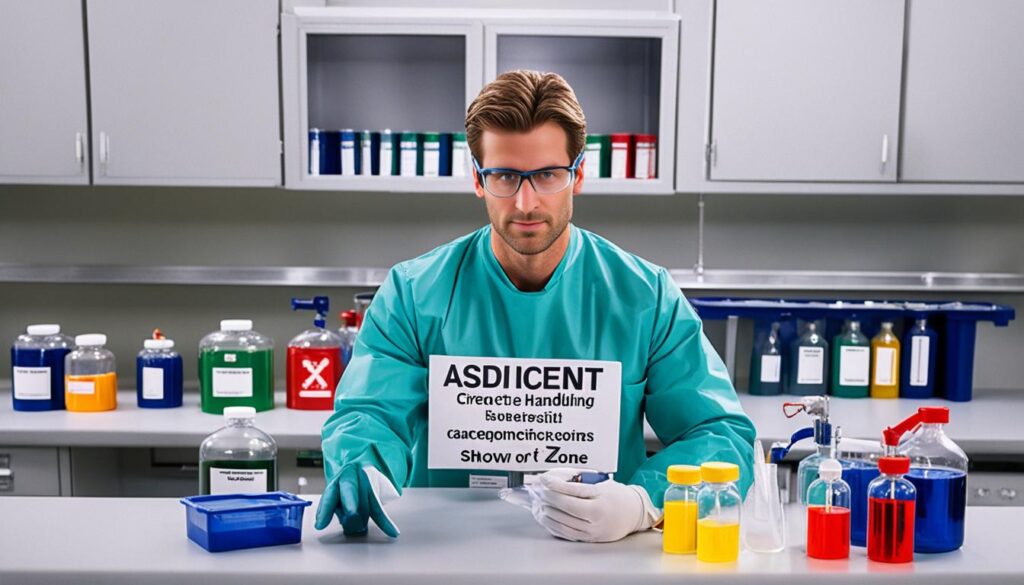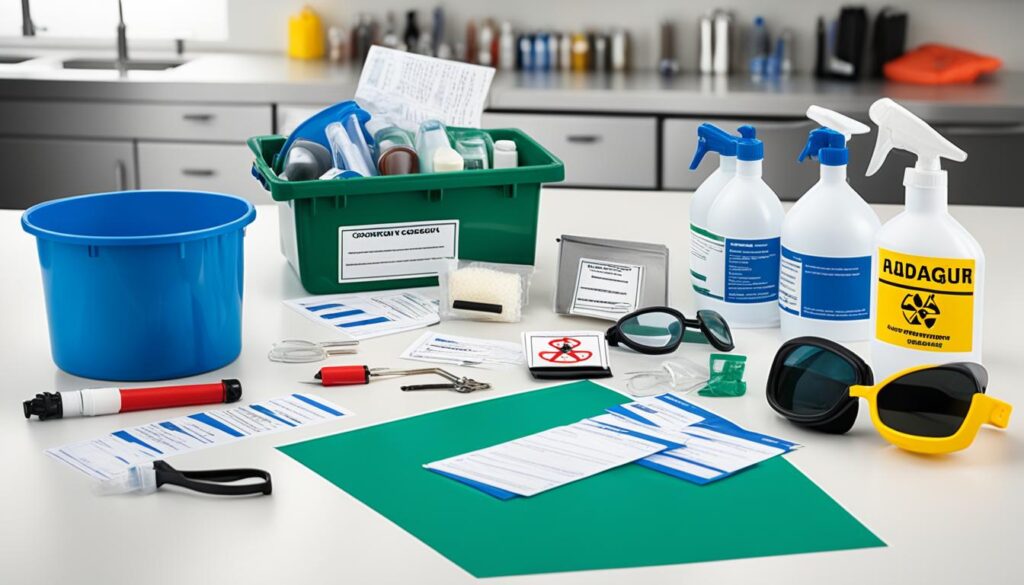Exploring science can be exciting and rewarding, but safety comes first, whether at home or in school. This guide will give you the knowledge and tools to explore science safely. It helps you become a confident scientist.
We’ll cover important safety steps, setting up a safe workspace, and handling dangerous materials. You’ll find fun science projects for different ages and resources to help you. Let’s start an exciting journey where curiosity and safety meet, exploring the world safely and responsibly.
Introduction to Safe Science Experimentation
Doing science experiments can be thrilling and rewarding, but safety must come first. It’s key to keep everyone and the experiment safe. By knowing and following safety rules, you can make sure your science experiment goes well.
Importance of Safety in Scientific Exploration
Safety is crucial in science experiments. It lowers the chance of accidents and protects people and things. Keeping a safe place to work makes sure your results are reliable and safe.
Thinking safety first is a must for anyone doing science experiments, whether you’re a scientist, student, or just curious.
Overview of Common Safety Precautions
To keep your science experiment safe, learn about common safety steps. This includes wearing things like goggles, gloves, and lab coats. It also means being careful with chemicals and keeping your work area clean.
Knowing what to do in an emergency and having first-aid tools ready is also important. This way, you can act fast if something goes wrong.
Putting safety first in your science experiments lets you explore fully and helps advance knowledge. It also keeps you and those around you safe.
Preparing a Safe Work Environment
Setting up a special area for your science experiments is key to safety and productivity. This could be in your home or garage. Make sure it’s well-ventilated and big enough for you to move easily. Keep it clean and free from things that could trip you up. Adding a strong workbench or table is also a good idea for your experiments.
Setting Up a Dedicated Workspace
When you’re setting up your science area, focus on safety and keeping things tidy. Choose furniture that’s strong and can handle your experiments. Use shelves or storage for things like goggles, gloves, and fire extinguishers. Make sure to have separate spots for chemicals, glassware, and other dangerous stuff.
Gathering Essential Safety Equipment
Having the right safety gear is a must for your science space. Start with things like eye protection, heat-proof gloves, and a first-aid kit. Think about getting a fume hood or a well-ventilated spot for handling flammable substances. Also, have a fire extinguisher, a spill kit, and a sink or safety shower ready for emergencies. Having these items close by will make your experiments safer and more confident.
Handling Chemicals and Hazardous Materials
Science experiments often use chemicals and hazardous materials. These need special care to stay safe. Understanding chemical safety data sheets, or MSDS, is key.
Understanding Chemical Safety Data Sheets
MSDS give info on a substance’s physical and chemical properties. They also offer guidance on safe handling, storage, and disposal. It’s vital to read the MSDS when working with chemicals. This helps you know about hazards like flammability, toxicity, or reactivity.
This info helps you protect yourself and your students during experiments. By knowing about chemical safety in science experiments and the MSDS, you handle hazardous materials safely. This keeps everyone in the lab safe and teaches your students about safety in science.

Science Experiments for Different Age Groups
Getting kids and teens involved in safe science experiments is a great way to spark their curiosity. It helps them develop a love for scientific discovery. For safe science experiments for kids and science experiments for teens, it’s key to pick activities that match their age and are fun and educational.
Young kids can start with simple experiments like growing crystals, making volcanoes, or learning about matter. These age-appropriate science projects introduce basic science concepts. They also help kids learn by doing and solving problems.
As kids get older, the experiments can get more complex. They can explore electricity, chemistry, or coding and robotics. Science experiments for teens should make them think deeply and solve problems. They should learn about complex science and use it in real ways.
It’s important to always follow safety rules, have the right safety gear, and watch over everyone. This makes sure the experience is safe and rewarding for all.
Proper Disposal of Experimental Waste
Science experiments can create different kinds of waste, some of which might be dangerous. It’s key to dispose of this waste right to keep the environment and people safe. Let’s look at why it’s important to know about hazardous waste and how to get rid of experimental waste safely.
Identifying Hazardous Waste
First, you need to spot any hazardous materials in your waste. These can be chemicals, solvents, batteries, and other dangerous stuff. Always check the safety data sheets for your experiment materials to see if they’re hazardous.
Responsible Disposal Methods
After finding the hazardous waste, you must dispose of it correctly. This might mean calling your local hazardous waste center or following rules from your school or lab. For safe stuff like paper, glass, or plastic, you can just throw it out with the regular trash.
Properly getting rid of experimental waste is crucial for safety and the environment. By identifying and disposing of waste correctly, you make sure your science experiments are green and safe.
First Aid and Emergency Preparedness
In the world of science experiments, safety comes first. It’s key to have a plan for first aid and emergencies. This is vital whether you’re at home, in a lab, or at a science fair. Being ready for emergencies can save lives.
For first aid, keep a first aid kit, eye-wash stations, and fire extinguishers handy. Learn how to deal with chemical spills, electrical shocks, and other dangers. This way, you can keep experiments safe and responsible.

It’s also important to prepare for emergencies in labs and classrooms. Create evacuation plans and practice them. Make sure everyone knows what to do in an emergency. Keep a list of emergency contacts and assign someone to handle emergencies.
Always put safety first in science experiments. Being proactive with first aid and emergency plans makes science safe and fun.
Supervising Children During Science Experiments
Doing science experiments with kids is fun and educational. But, it’s important to keep them safe. Using the right supervision techniques is key for a safe and fun learning space.
Age-Appropriate Supervision Techniques
For young kids, like those in elementary school, you need to be very close. Stay right with them as they do experiments. Help them with any tricky materials or tools and answer their questions.
As kids get older, like in middle and high school, they can do more on their own. But, you still need to watch them closely. Make sure they follow safety rules and use equipment right. Help them think deeply, observe, and come to their own conclusions.
No matter the age, adjust how you supervise based on what the kids need and can do. Finding the right mix of guidance and independence helps them learn important science skills. And, it keeps them safe and happy.
Science Fair Project Safety Guidelines
Starting a science fair project is exciting and educational. But, safety must come first. There are key guidelines to follow for a safe and successful project.
First, learn the safety rules for your science fair. Many fairs give clear instructions on handling chemicals and equipment. Make sure you know these rules to stay safe.
Also, set up a safe workspace for your project. Keep it well-ventilated and clean. Have safety gear like goggles, gloves, and a first-aid kit ready. This helps prevent accidents.
When using chemicals, always check the safety data sheets (SDS). These have important info on handling and disposing of materials safely. Follow the SDS to keep yourself and others safe.
Lastly, plan how to safely dispose of waste or hazardous materials. Talk to your fair organizers or local authorities for the right way to do it. By doing this, you can have a safe and successful science fair project.
Online Resources for Safe Science Experimentation
Starting safe science experiments is easier and more fun with online resources. Many websites have guides, educational stuff, and expert advice. They help make your science adventures safe and fun.
Check out sites like the American Chemical Society’s “Safety in the Science Classroom” or the National Science Teachers Association’s “Safety in the Science Classroom”. They have clear rules, how to spot dangers, and the best ways to work. You’ll learn how to handle chemicals, set up a safe work area, and supervise kids the right way.
There are also many science safety guides, like interactive lessons, videos, and plans you can download. Groups like the Occupational Safety and Health Administration (OSHA) and the Centers for Disease Control and Prevention (CDC) have lots of resources. They help you learn about keeping labs safe and being ready for emergencies.



